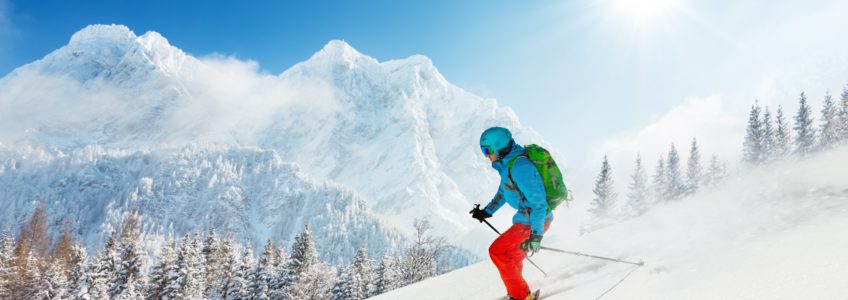
With winter in full swing, Southern California mountains are full of fresh snow, which means thousands of enthusiasts will hit to the slopes to enjoy the ideal skiing conditions. Unfortunately, skiing can also result in injuries. Typically, skiing injuries affect the lower extremities, most commonly the knee. Thanks to advances in ski technology, like the introduction of releasable bindings, has significantly lowered the risk of leg fractures but injuries like knee sprains (including ACL and/or MCL tears) are still on the rise.
Common Ski-Related Knee Injuries
MCL Injuries: The most common skiing-related injury is the medial collateral ligament (MCL) tear, which is often treated without surgery. The MCL is located on the medial, or inner, side of the knee and assists in the stabilization of the knee joint. When a skier or snowboarder lands awkwardly, he/she can suffer a twisting injury to the knee, resulting in painful and debilitating ligament injuries such as MCL tears. MCL tears are more common among beginning and intermediate skiers because a less experienced skier may allow the ski tips to point toward one another in a snowplow position (the common slow or stop position), causing the skier to fall down the hill.
ACL Injuries: The second most common injury is the anterior cruciate ligament (ACL) tear. The ACL runs diagonally in the middle of the knee, preventing the tibia from sliding out in front of the femur, as well as providing rotational stability to the knee. Unlike MCL tears, ACL tears often require surgery given the importance of the ACL to the functional stability of the knee. ACL tears are common among athletes but most of them result from “non-contact” injuries.
Meniscus Injuries: Bruising or tearing to the meniscus is a frequently encountered skiing injury. The medial meniscus and lateral meniscus are located on either side of the joint, between the cartilage surfaces of the femur and tibia, and act as shock absorbers to reduce the stresses between those two bones. Injuries to menisci may result from twisting the knee when maneuvering ski turns or from a bad landing following a jump.
Fractures: Decades ago, broken legs were common because skis would often not come off at the right time. Advancements in technology, including improved binding-release settings and parabolic skis have notably decreased the number of lower-leg injuries, especially shinbone fractures. It is now more common to see injuries to the ligaments of the knee, though fractures do still occur.
How to Avoid Ski-Related Knee Injuries
While risk of injury is always present when you hit the slopes, there are a few tips to keep in mind that may help you to avoid common ski injuries.
1. Prepare Yourself Before Skiing: If you have not put on skis in a while, it is best to prepare your body with some conditioning exercises at least six weeks prior to skiing. Include exercises such as walking lunges, wall squats and at least 30 minutes of intense cardio several times per week to strengthen your knees and leg muscles.
2. Perform Warm-up Exercises: Cold muscles are more prone to injury so it is best to perform at least 15 minutes of simple stretching exercises before hitting the slopes.
3. Know the Ice or Snow Conditions and Be Aware of Your Skill Level: The condition of the snow can change the terrain so it is important for you to be familiar with the snow condition and stick to the slopes suitable to your level.
4. Fall the Right Way: Take the fall; fighting it is how ligaments get torn. If you can, sit down to break the momentum. Pull your limbs in towards the torso. This will prevent you from dislocating your shoulder or straining your knee when you fall from a jump.
5. Don’t Overdo It: Forget trying to impress your friends. Start out on easier terrain and improve your skills gradually. And even before that, get in shape with proper training.
6. Follow the Skier’s “Code of Conduct”: The common-sense rules you see posted on the slopes are for your protection and the safety of others.
7. Take Breaks: Sure, you want to maximize your ski time. But injury rates increase with fatigue. Rest when you need to and stay hydrated with water or sport drinks.
Getting Ready
Many common ski injuries occur when the skier has not conditioned their body properly. Conditioning should begin weeks before you hit the slopes.
1. Flexibility: Make sure that your body is prepared beforehand with stretching exercises that focus on the lower extremities and increase flexibility. This helps avoid muscle tears and nerve damage.
2. Muscular Strength: Build up muscular strength to help you remain calm and in control, even when an accident is imminent. Focus on core and leg strength to strengthen muscles.
3. Agility & Endurance: Agility exercises include sprints, stair drills and weighted walking. Endurance exercises rely heavily on cardiovascular strength. Employ a program that includes biking, running or swimming. Both agility and endurance conditioning also strengthens the heart, lungs and legs.
4. Balance Training: Practicing balance should also be the main focus in a conditioning program. This can be accomplished with a balance board or balance exercises.
Where can I find an experienced orthopedist to treat my skiing injury in Southern California?
While skiing can be a fun and adventurous way to spend winter months, skiing injuries unfortunately can and do happen. When you are facing any type of skiing injury, it is important to see a top orthopedic specialist for proper diagnosis and treatment. The experienced and dedicated sports medicine doctors and surgeons at Ventura Orthopedics are here for you. If you are concerned about a skiing-related injury, talk to the experts at Ventura Orthopedics today.
Call us today at 800-698-1280 to schedule an appointment.

